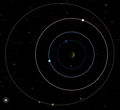Jool
Jool is a gas giant and the sixth planet of the Kerbol star system. It is the Jupiter analog for Kerbal Space Program. Aside from Kerbol, Jool has the largest diameter and greatest mass of all celestial bodies. While its distance from Kerbin makes it difficult to reach, it is one of the most appealing targets for missions due to its large and complex system of five moons: Laythe, Vall, Tylo, Bop, and Pol.
Contents
In-game Description
| “ | Jool is particularly known for being a rather large, predominantly green planet. Kerbalkind has longed to visit it since it was first spotted in the sky. Philosophers reason that the swirling green planet must be a really nice place to visit, on account of its wholesome coloration. If you look at Jool through a telescope, it is fuzzy. — Kerbal Astronomical Society |
” |
Atmosphere
Although Jool has a radius ten times greater than Kerbin, its atmosphere begins just twice as high (138.2 km). It is extremely dense, well suited for aerobraking from a high-speed interplanetary intercept. Orbiting just outside the atmosphere will give a period of 94.74 minutes, and an orbital speed of 6,785 m/s. Typically an altitude lower than 100 km is not needed for aerobraking, and it may be wise to stay in the upper atmosphere because a bug can occur causing the ship to spontaneously explode or glitch out Kerbals on EVA.
In general, the atmospheric pressure on Jool at an altitude expressed in meters is:
Closer to the surface, the physics of the game start to break down. Due to its extremely thick atmosphere, terminal speed is so low that lighter spacecraft will not even need parachutes or retrorockets. It is possible to land on its solid surface, though spacecraft are inevitably and invariably devoured by the Kraken. If the craft is very small, it may survive the Kraken, but the parts will explode once they are 100m below the surface. The message "... collided with Cloud" will be displayed in the mission summary. The game may glitch out and corrupt the save.
If a kerbonaut is put on EVA he will not be destroyed, making one-way sacrificial landings possible. However, as seen near the end of this video, the kerbonaut will start to glitch out and shake uncontrollably. This only happens on 4× time warp. The game will later glitch and the Hell Kraken will stike. Unless you restart the game, Kerbin's atmosphere will be missing.
This glitch, while most common on Jool, is not unique to Jool, and can even be experienced on Kerbin in extreme situations; for example, going on EVA from a high speed spaceplane as it takes off can occasionally cause this, or it can even (although much more rarely) happen in less intense situations as simple as sliding slowly on the Mun. If you do experience this outside of Jool, it is very difficult to replicate, which is why recordings of this are so rare.
It is possible to land and plant flags on Jool.[1]
Reference Frames
| Time warp | Minimum Altitude |
|---|---|
| 1× | Any |
| 5× | 200 000 m (above the atmosphere) |
| 10× | 200 000 m (above the atmosphere) |
| 50× | 200 000 m (above the atmosphere) |
| 100× | 200 000 m (above the atmosphere) |
| 1 000× | 300 000 m |
| 10 000× | 600 000 m |
| 100 000× | 1 200 000 m |
Natural Satellites
 The ocean moon Laythe, about to transit Jool. Jool has five natural satellites, each with an orbit well-aligned with Jool's orbital plane:
Laythe, Vall, and Tylo are in a Laplace resonance, with orbital periods of 1:2:4 respectively. Despite the fact that the moons can easily eclipse both each other and Jool, they do not. Synchronous Orbits around any of the Joolian moons are impossible, as they all lie outside the Sphere of Influence of the moons, as is common with tidally locked bodies. |
Gallery
- → See also: Images of Jool
Trivia
- Jool has roughly the same equatorial radius as the planets Earth and Venus.
- The sunsets and sunrises on Jool are a shade of yellowish brown.
- Like Jool, Jupiter's nearest three moons (Io, Europa, and Ganymede) have a Laplace resonance of 1:2:4.
- Jool, Laythe and Tylo all have a surface gravity of 7.85 m/s² (≃ 0.8 g)
- The green gas which composes Jool could be chlorine.
- Despite not having a surface, the game file contain what the Kerbals say in the different reports/observations (ScienceDefs.cfg) also contains some reports while landed on the surface of Jool.
- EVA Report: You're not sure how you even landed on the surface of a gas giant. But it's probably best not to think about it for too long..
- Materials Study: You're not sure where the container stops and the samples start anymore...
- Atmospheric Pressure Scan: Either the pressure is really high, or the instrument just melted. It's hard to tell what happened first.
- Seismic Scan 1: The sensor doesn't even know what to do with itself here.
- Seismic Scan 2: The sensor has informed you that the warranty has just been voided. No refunds.
- Gravity Scan: The instrument has been crushed by the massive gravitational forces. Science!
- Atmosphere Analysis: The instrument has mostly compressed into an unrecognizable mass of metal.
Notes
- ↑ “Kerbal Space Program: Planting a Flag on Jool” by Dahud Lefthanded in version 0.20
Changes
- Added a new, more distant moon named Pol.
- Initial Release










